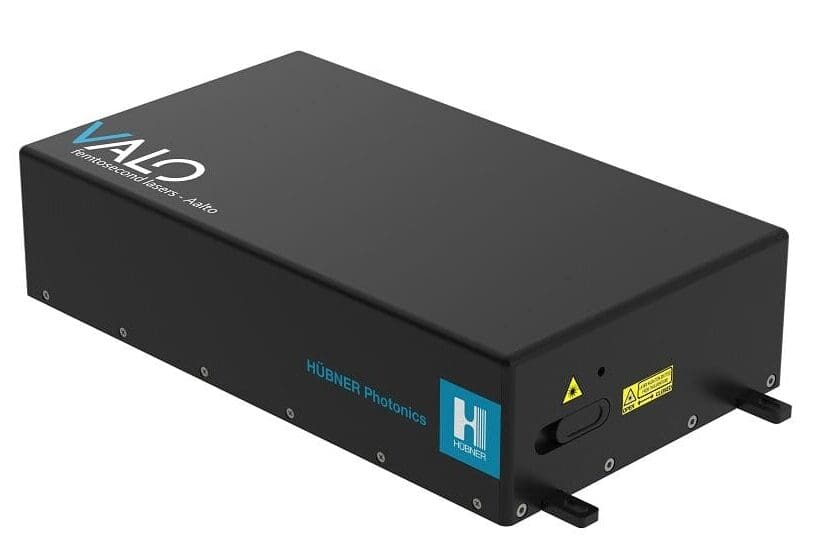Femtosecond lasers
What are femtosecond lasers and why do we use them?
Lasers emit light either continuously or in a train of pulses. Within the large group of ultrafast lasers, we can find a certain group of lasers that produce picosecond, femtosecond or even nanosecond pulse durations at different repetition frequencies.
Femtosecond lasers emit optical pulses with a pulse duration in the domain of femtoseconds typically ranging between a few femtoseconds to hundreds of femtoseconds. So, femtosecond lasers focus the energy on a very short time scale within a single laser pulse. That leads to high peak powers that cannot be achieved by continuous wave lasers, for instance.
Femtosecond pulses can be generated by different kinds of laser technologies, commonly solid state lasers (Ti:sapphire lasers) or more recently, fiber lasers. In general fiber lasers offer a lot of advantages compared to solid state lasers.
Advantages of using femtosecond fiber laser technology
Ultrafast fiber lasers have revolutionized the field of photonics. One of the main advantages of using ultrafast femtosecond fiber lasers is the high peak power they offer which makes them ideal for a wide range of applications where peak power is especially important. These applications include precision micromachining, medical procedures, and especially biomedical imaging such as multiphoton microscopy.
Due to the waveguide effect of optical fibers the laser systems have very good thermal and vibrational stability and can produce nearly diffraction limited beam profiles. In general fiber lasers offer a low cost of ownership and they are essentially maintenance-free.
In addition, due to the amorphous structure of the glass, the gain bandwidth of rare earth doped optical fibers is much more wideband compared to solid state doped materials. Therefore, fiber lasers can offer a wide wavelength tunablity. In addition, a large gain bandwidth also enables the generation of ultrashort optical pulses. Typical ultrafast pulse durations are determined by the optical gain bandwidth, so the wider the bandwidth the shorter the pulse that can be generated in theory.
A new approach to cancer treatment with femtosecond lasers
Dr. Groot from Vrije University, Amsterdam, proposes a novel approach using VALO lasers for the imaging of tissue for a biopsy based drug test bed.
In the realm of cancer treatments, response rates typically average around 30 percent, leaving many patients unresponsive to standard therapies while still enduring their side effects. Dr. Groot introduces a groundbreaking alternative: a method where clinicians take a biopsy sample—whether obtained endoscopically or surgically—and place it into a culture chamber, keeping it alive for five days. During this time, they administer two or three potential treatments envisioned for the patient.
Following this, physicians can observe how the tissue responds to these treatments, allowing them to predict the patient’s potential response. This approach enables ongoing monitoring of tissue dynamics and facilitates the development of further diagnostic tests.
This innovative technique is made feasible by employing ultra-short laser pulses characterized by a low repetition rate and low average power. This laser technology avoids tissue damage and heating, preserving tissue integrity. The VALO lasers offer numerous advantages, particularly within clinical settings. Clinicians can develop portable devices and use short pulse durations for label-free microscopy to image tissue samples.
The applications are vast, including instant pathology—a currently unmet clinical need—and live tissue imaging, which unlocks myriad possibilities in both clinical and pharmaceutical contexts. This novel approach heralds a new era in personalized cancer treatment assessment and monitoring.
Introducing the ultrafast lasers by VALO
Thanks to an innovative laser design with sophisticated control of dispersion and non-linear effects, the VALO Femtosecond Series lasers offer ultra-short pulses with pulse durations below 50 fs from a compact, robust and turn-key system.
With outstandingly high pulse peak power levels and computer controlled group velocity dispersion pre-compensation, the VALO ultrafast femtosecond fiber lasers are ideal for multiphoton imaging, neuroscience, optogenetics and advanced spectroscopy applications.
The VALO Femtosecond Series lasers have an even higher optical bandwidth than the gain bandwidth due to a perfect interaction of linear and nonlinear effects. Due to this unique design, the VALO Femtosecond Series lasers can generate clean ultrafast optical pulses with pulse durations below 50 fs at unmatched power levels.
- <40 fs pulse duration
- Up to 3 W output power
- Very low noise
- Integrated pre-compensation dispersion module

VALO Femtosecond Series
Ultrafast femtosecond fiber lasers
Pulse duration: <40 fs
Power: Up to 3 W
Applications: Multiphoton Microscopy, Two-photon Polymerization, Optogenetics.
Finding the ideal ultra-fast laser source for a multiphoton imaging setup is not trivial. It is a fine balance between peak power, pulse energy and laser wavelength. In this white paper we discuss important laser parameters and the impact these laser parameters have on the quality of the results.
Read more on Sub 50 femtosecond pulse lasers for gentler multiphoton microscopy

